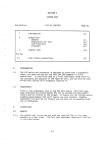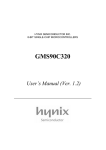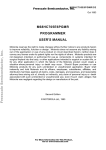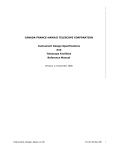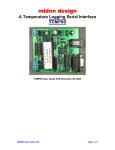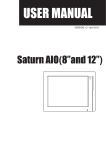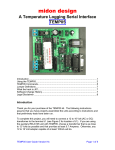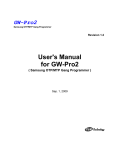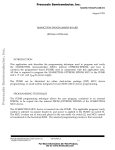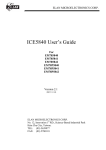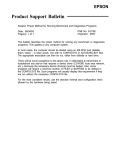Download M68HC05PGMR
Transcript
M68HC05PGMR-2/D Rev 2 April 1995 M68HC05PGMR-2 PROGRAMMER USER'S MANUAL Third Edition © MOTOROLA Ltd., 1994, 1995; All Rights Reserved M68HC05PGMR-2/D 2-1 MOTOROLA Motorola reserves the right to make changes without further notice to any products herein to improve reliability, function, or design. Motorola does not assume any liability arising out of the application or use of any product or circuit described herein; neither does it convey any license under its patent rights nor the rights of others. Motorola products are not designed, intended, or authorized for use as components in systems intended for surgical implant into the body, or other application in which the failure of the Motorola product could create a situation where personal injury or death may occur. Should Buyer purchase or use Motorola products for any such unintended or unauthorized application, Buyer shall indemnify and hold Motorola and its officers, employees, subsidiaries, affiliates, and distributors harmless against all claims, costs, damages, and expenses, and reasonable attorney fees arising out of, directly or indirectly, any claim of personal injury or death associated with such unintended or unauthorized use, even if such claim alleges that Motorola was negligent regarding the design or manufacture of the part. Motorola and the Motorola logo are registered trademarks of Motorola Inc. Motorola Inc. is an Equal Opportunity/Affirmative Action Employer. M68HC05PGMR-2/D 2-2 MOTOROLA Table of Contents 1. INTRODUCTION...................................................................................1-5 1.1 BOARD LAYOUT AND DESCRIPTION...................................................................................1-6 2. PROGRAMMING PROCEDURES . . . . . . . . . . . . . . . . . . . . . . . . . . . . . . . . . . . . . . . . . . . . . . . . . . . . . . . . . . . . . . 2 - 7 2.1 68HC805C4 PROGRAMMING AND VERIFYING....................................................................2-7 2.1.1 Programming Procedure.....................................................................................................2-7 2.1.2 Notes on the Programming Operation...................................................................................2-7 2.1.3 Verifying Procedure...........................................................................................................2-8 2.1.4 Notes on the Programming Operation...................................................................................2-8 2.2 68HC705C5 PROGRAMMING AND VERIFYING....................................................................2-9 2.2.1 Programming Procedure.....................................................................................................2-9 2.2.2 Notes on the Programming Operation...................................................................................2-9 2.2.3 Verifying Procedure.........................................................................................................2-10 2.2.4 Notes on the Programming Operation.................................................................................2-10 2.3 68HC705C8 PROGRAMMING AND VERIFYING..................................................................2-11 2.3.1 Programming Procedure...................................................................................................2-11 2.3.2 Notes on the Programming Operation.................................................................................2-11 2.3.3 Verifying Procedure.........................................................................................................2-12 2.3.4 Notes on the Verifying Operation......................................................................................2-12 2.3.5 Secure EPROM Operation................................................................................................2-13 2.4 68HC705C9/D9 PROGRAMMING AND VERIFYING.............................................................2-14 2.4.1 Programming Procedure...................................................................................................2-14 2.4.2 Notes on the Programming Operation.................................................................................2-14 2.4.3 Verifying Procedure.........................................................................................................2-15 2.4.4 Notes on the Verifying Operation......................................................................................2-15 M68HC05PGMR-2/D 2-3 MOTOROLA THIS PAGE INTENTIONALLY LEFT BLANK M68HC05PGMR-2/D 2-4 MOTOROLA CHAPTER 1. INTRODUCTION This manual describes the procedure used to program and verify an MC68HC(7/8)05C series microcontroller (MCU) on the M68HC05PGMR-2. All that is required to program the MCU is the PGMR, +5 volt and VPP dc power supply, and a pre-programmed EPROM. The PGMR provides programming for either 40 pin dual-in-line package (DIP) MCU device programming, or 44 pin plastic leaded chip carrier (PLCC) MCU device programming. Install power leads at P1 S1 controls power to the MCU S2 controls the MCU RESET Jumper Headers configure the PGMR JP3 P1 S1 S2 JP1 JP2 JP5 S3 JP4 P2 SKT2 SKT1 SKT3 SKT1 contains the program EPROM Install the 40DIP MCU in SKT2 OR Install the 44PLCC MCU in SKT1 Figure 1.1 M68HC05PGMR-2 Layout M68HC05PGMR-2/D 2-5 MOTOROLA 1.1 BOARD LAYOUT AND DESCRIPTION Figure 1.1 shows the layout of the PGMR. As shown in the figure there are various controls, connectors and sockets that provide the ability to configure the board to specific MCU programming requirements. For the board to function correctly you must supply the required power to the board at connector P1. +5V dc @ 100mA and ground lines are required. In addition a VPP power supply is needed to perform the programming. The value of this supply may vary between MCUs, please refer to this manual and the device data book for further information. Switches S1 and S2 control the activity of the PGMR. S1 is a simple on/off switch that applies power to the MCU device when on. Never remove or install an MCU when the S1 switch is in the ON position. S2 control the MCU reset line. Programming cannot take place while the part is in reset mode. Five jumper headers (JP1 to JP5) configure the PGMR for the particular MCU and function in use. They select between different MCUs, EPROM sizes, and modes. The following sections describe how to configure these jumpers for your programming requirements. Lastly, sockets SKT1 to SKT3 allow for the installation of the MCUs and the master EPROM. SKT1 is for installation of the EPROM that contains all the data being programmed into the MCU. SKT2 provides support for a 40 pin DIP package and SKT3 for a 44 pin PLCC package. Not all of the MCUs supported by this board may be available in each package. The SKT3 socket requires that the MCU is installed in a top-down or deadbug fashion. IMPORTANT NOTE You must never install more than one MCU on this board at any time. That is there must never be an MCU installed in SKT2 and another installed in SKT3 simultaneously. Such a configuration may damage either of the MCUs and the board itself. Always ensure that the devices are orientated correctly into their respective sockets. M68HC05PGMR-2/D 2-6 MOTOROLA CHAPTER 2. PROGRAMMING PROCEDURES The programmer copies a user program contained in an external EPROM, into the internal PROM (OTPROM/EPROM) or EEPROM (C4 only) of the MCU device The following sections describe the procedure taken to program each MCU type. 2.1 68HC805C4 PROGRAMMING AND VERIFYING There are two procedures used: one for programming and verifying and one that allows verifying only. 2.1.1 Programming Procedure Settings required: JP1 JP3 JP5 S2 SKT1 No Connection C4/C8 PROG IN 27C64 EPROM Installed JP2 JP4 S1 S3 C4/C8 27C64/27C128 OFF OFF OFF OFF OFF a) Apply power to the PGMR board. b) Insert the 805C4 MCU device into the PGMR. c) Set S1 to ON. d) Set S2 to OUT. The selected programming routine is then executed. e) Once the programming is complete (see section 2.1.2), set S2 to IN and S1 to OFF. You may now remove the MCU from the socket. 2.1.2 Notes on the Programming Operation In the program and verify MCU PROM routine, the contents of an external EPROM are copied into the MCU EEPROM. There is a direct correlation of addresses between the two devices (MCU and external EPROM). Non-MCU EEPROM addresses are ignored so data contained in those areas are not accessed. Unprogrammed EEPROM address locations should contain $FF to speed up the programming operation. During the programming routine, the PROGRAM LED D6 is illuminated. At the end of the programming routine, D6 is turned off, and the verification routine is entered. If the contents of the MCU EEPROM and external EPROM exactly match, then the VERIFY LED D5 is illuminated. M68HC05PGMR-2/D 2-7 MOTOROLA During the verification routine, all locations are compared to the data residing in external EPROM. The verification routine will stop if a discrepancy has been detected and the error address location will be placed on the external memory address bus. 2.1.3 Verifying Procedure Settings required: JP1 JP3 JP5 S2 SKT1 No Connection C4/C8 PROG IN 27C64 EPROM Installed JP2 JP4 S1 S3 C4/C8 27C64/27C128 OFF OFF ON OFF OFF a) Apply power to the PGMR board. b) Insert the 805C4 MCU device into the PGMR. c) Set S1 to ON. d) Set S2 to OUT. The selected verification routine is then executed. e) Once the verification is complete (see section 2.1.4), set S2 to IN and S1 to OFF. You may now remove the MCU from the socket. 2.1.4 Notes on the Programming Operation The verify MCU EEPROM contents routine is normally entered automatically after the MCU EEPROM is programmed. Direct entry of this mode will cause the MCU EEPROM contents to be compared to external EPROM contents residing at the same address locations. Both D5 and D6 LEDs are turned off at this time until verification is completed. Upon completion of the verification routine (every location verified) the VERIFIED LED D5 is illuminated. If D5 does not illuminate, a discrepancy has been detected and the error address location will be placed on the external memory address bus. NOTE MCU EEPROM blank checking can be accomplished by placing $FF into the locations of the external EPROM that map those of the MCU EEPROM. The above verify MCU routine will then verify that the device is blank. M68HC05PGMR-2/D 2-8 MOTOROLA 2.2 68HC705C5 PROGRAMMING AND VERIFYING There are two procedures used: one for programming and verifying and one that allows verifying only. 2.2.1 Programming Procedure Settings required: JP1 JP3 JP5 S2 SKT1 No Connection C4/C8 PROG IN 27C64 EPROM Installed JP2 JP4 S1 S3 C4/C8 27C64/27C128 OFF ON OFF OFF OFF a) Apply power to the PGMR board. b) Insert the 705C5 MCU device into the PGMR. c) Set S1 to ON. d) Set S2 to OUT. The selected programming routine is then executed. e) Once the programming is complete (see section 2.1.2), set S2 to IN and S1 to OFF. You may now remove the MCU from the socket. 2.2.2 Notes on the Programming Operation In the program and verify MCU EPROM routine, the contents of an external EPROM are copied into the MCU EPROM. There is a direct correlation of addresses between the two devices (MCU and external EPROM). Non-MCU EPROM addresses are ignored so data contained in those areas are not accessed. Unprogrammed EPROM address locations should contain $00 to speed up the programming operation. During the programming routine, the PROGRAM LED D6 is illuminated. At the end of the programming routine, D6 is turned off, and the verification routine is entered. If the contents of the MCU EPROM and external EPROM exactly match, then the VERIFY LED D5 is illuminated. During the verification routine, all locations are compared to the data residing in external EPROM. The verification routine will stop if a discrepancy has been detected and the error address location will be placed on the external memory address bus. M68HC05PGMR-2/D 2-9 MOTOROLA 2.2.3 Verifying Procedure Settings required: JP1 JP3 JP5 S2 SKT1 No Connection C4/C8 PROG IN 27C64 EPROM Installed JP2 JP4 S1 S3 C4/C8 27C64/27C128 OFF ON ON OFF OFF a) Apply power to the PGMR board. b) Insert the 705C5 MCU device into the PGMR. c) Set S1 to ON. d) Set S2 to OUT. The selected verification routine is then executed. e) Once the verification is complete (see section 2.2.4), set S2 to IN and S1 to OFF. You may now remove the MCU from the socket. 2.2.4 Notes on the Programming Operation The verify MCU PROM contents routine is normally entered automatically after the MCU EPROM is programmed. Direct entry of this mode will cause the MCU EPROM contents to be compared to external EPROM contents residing at the same address locations. Both D5 and D6 LEDs are turned off at this time until verification is completed. Upon completion of the verification routine (every location verified) the VERIFIED LED D5 is illuminated. If D5 does not illuminate, a discrepancy has been detected and the error address location will be placed on the external memory address bus. NOTE MCU EPROM blank checking can be accomplished by placing $00 into the locations of the external EPROM that map those of the MCU EPROM. The above verify MCU routine will then verify that the device is blank. M68HC05PGMR-2/D 2-10 MOTOROLA 2.3 68HC705C8 PROGRAMMING AND VERIFYING There are two procedures used: one for programming and verifying and one that allows verifying only. See section 2.3.5 for procedures used when securing the C8 EPROM. 2.3.1 Programming Procedure Settings required: JP1 JP3 JP5 S2 SKT1 No Connection C4/C8 PROG IN 27C64 EPROM Installed JP2 JP4 S1 S3 C4/C8 27C64/27C128 OFF OFF OFF OFF OFF a) Apply power to the PGMR board. b) Insert the 705C8 MCU device into the PGMR. c) Set S1 to ON. d) Set S2 to OUT. The selected programming routine is then executed. e) Once the programming is complete (see section 2.1.2), set S2 to IN and S1 to OFF. You may now remove the MCU from the socket. 2.3.2 Notes on the Programming Operation In the program and verify MCU EPROM routine, the contents of an external EPROM are copied into the MCU EPROM. There is a direct correlation of addresses between the two devices (MCU and external EPROM). Non-MCU EPROM addresses are ignored so data contained in those areas are not accessed. Unprogrammed EPROM address locations should contain $00 to speed up the programming operation. During the programming routine, the PROGRAM LED D6 is illuminated. At the end of the programming routine, D6 is turned off, and the verification routine is entered. If the contents of the MCU EPROM and external EPROM exactly match, then the VERIFY LED D5 is illuminated. During the verification routine, all locations are compared to the data residing in external EPROM. The verification routine will stop if a discrepancy has been detected and the error address location will be placed on the external memory address bus. M68HC05PGMR-2/D 2-11 MOTOROLA 2.3.3 Verifying Procedure Settings required: JP1 JP3 JP5 S2 SKT1 No Connection C4/C8 PROG IN 27C64 EPROM Installed JP2 JP4 S1 S3 C4/C8 27C64/27C128 OFF OFF ON OFF OFF a) Apply power to the PGMR board. b) Insert the 705C8 MCU device into the PGMR. c) Set S1 to ON. d) Set S2 to OUT. The selected verification routine is then executed. e) Once the verification is complete (see section 2.3.4), set S2 to IN and S1 to OFF. You may now remove the MCU from the socket. 2.3.4 Notes on the Verifying Operation The verify MCU PROM contents routine is normally entered automatically after the MCU EPROM is programmed. Direct entry of this mode will cause the MCU EPROM contents to be compared to external EPROM contents residing at the same address locations. Both D5 and D6 LEDs are turned off at this time until verification is completed. Upon completion of the verification routine (every location verified) the VERIFIED LED D5 is illuminated. If D5 does not illuminate, a discrepancy has been detected and the error address location will be placed on the external memory address bus. NOTE MCU EPROM blank checking can be accomplished by placing $00 into the locations of the external EPROM that map those of the MCU EPROM. The above verify MCU routine will then verify that the device is blank. M68HC05PGMR-2/D 2-12 MOTOROLA 2.3.5 Secure EPROM Operation The 705C8 contains a security bit that prevents reading of the internal EPROM. Use the secure PROM routines after you successfully program and verify the EPROM. This procedure only programs the SEC bit of the OPTION register ($1FDF), but VPP is necessary. Once this bit is programmed, PROM is secure, and you cannot verify it. No LED illuminates during this routine and no verification occurs. To ensure that security is proper enabled, attempt to perform another verify routine (2.3.3). If the green LED does not light, the EPROM is secure. Settings required: JP1 JP3 JP5 S2 SKT1 No Connection C4/C8 PROG IN 27C64 EPROM Installed JP2 JP4 S1 S3 C4/C8 27C64/27C128 OFF OFF ON OFF ON a) Apply power to the PGMR board. b) Insert the 705C8 MCU device into the PGMR. c) Set S1 to ON. d) Set S2 to OUT. The selected programming routine executes. e) Once the programming is complete, set S2 to IN and S1 to OFF. You may now remove the MCU from the socket. M68HC05PGMR-2/D 2-13 MOTOROLA 2.4 68HC705C9/D9 PROGRAMMING AND VERIFYING There are two procedures used: one for programming and verifying and one that allows verifying only. Use the same procedure for a C9 or a D9. 2.4.1 Programming Procedure Settings required: JP1 JP3 No Connection C9/D9 JP2 JP4 JP5 S2 SKT1 PROG S1 IN S3 27C128 or 27C256 EPROM Installed C9/D9 27C64/27C128 if 27C128 installed 27C256 if 27C256 installed OFF OFF OFF OFF OFF a) Apply power to the PGMR board. b) Insert the 705C9 or 705D9 MCU device into the PGMR. c) Set S1 to ON. d) Set S2 to OUT. The selected programming routine is then executed. e) Once the programming is complete (see section 2.4.2), set S2 to IN and S1 to OFF. You may now remove the MCU from the socket. 2.4.2 Notes on the Programming Operation In the program and verify MCU EPROM routine, the contents of an external EPROM are copied into the MCU EPROM. There is a direct correlation of addresses between the two devices (MCU and external EPROM). Non-MCU EPROM addresses are ignored so data contained in those areas are not accessed. Unprogrammed EPROM address locations should contain $00 to speed up the programming operation. During the programming routine, the PROGRAM LED D6 is illuminated. At the end of the programming routine, D6 is turned off, and the verification routine is entered. If the contents of the MCU EPROM and external EPROM exactly match, then the VERIFY LED D5 is illuminated. During the verification routine, all locations are compared to the data residing in external EPROM. The verification routine will stop if a discrepancy has been detected and the error address location will be placed on the external memory address bus. M68HC05PGMR-2/D 2-14 MOTOROLA 2.4.3 Verifying Procedure Settings required: JP1 JP3 No Connection C9/D9 JP2 JP4 JP5 S2 SKT1 PROG S1 IN S3 27C128 or 27C256 EPROM Installed C4/C8 27C64/27C128 if 27C128 installed 27C256 if 27C256 installed OFF OFF ON OFF OFF a) Apply power to the PGMR board. b) Insert the 705C9 or 705D9 MCU device into the PGMR. c) Set S1 to ON. d) Set S2 to OUT. The selected verification routine is then executed. e) Once the verification is complete (see section 2.4.4), set S2 to IN and S1 to OFF. You may now remove the MCU from the socket. 2.4.4 Notes on the Verifying Operation The verify MCU PROM contents routine is normally entered automatically after the MCU EPROM is programmed. Direct entry of this mode will cause the MCU EPROM contents to be compared to external EPROM contents residing at the same address locations. Both D5 and D6 LEDs are turned off at this time until verification is completed. Upon completion of the verification routine (every location verified) the VERIFIED LED D5 is illuminated. If D5 does not illuminate, a discrepancy has been detected and the error address location will be placed on the external memory address bus. NOTE MCU EPROM blank checking can be accomplished by placing $00 into the locations of the external EPROM that map those of the MCU EPROM. The above verify MCU routine will then verify that the device is blank. M68HC05PGMR-2/D 2-15 MOTOROLA This page intentionally left blank M68HC05PGMR-2/D 2-16 MOTOROLA
















